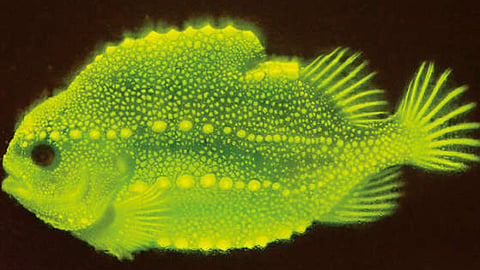

What colour is a lumpfish? The answer is more complicated than you might expect. These bumpy, bottom-dwelling fish, found in the North Atlantic and parts of the Arctic Ocean, come in a variety of colours, which change as the fish age. However, scientists think they have pinned down the fish’s true colour — fluorescent green. In a study published this month, scientists discovered that lumpfish glow under UV light. They believe these fish use their biofluorescent radiance to identify and possibly communicate with one another. In recent years, biofluorescence has been observed in cat sharks, wombats, flying squirrels and many other species. And now, add the lumpfish to nature’s cast of secretly glowing animals.
Lumpfish are solitary creatures that spend most of their lives on the seafloor. These funny-looking fish latch onto rocks and seaweed, using a modified pelvic fin on their underside that acts like a suction cup to help them hang out until something tasty swims by.
They’ve also become pseudo-celebrities on TikTok, where a ceaseless stream of videos posted by researchers and fishermen have amassed millions of views. “It’s a pretty clunky, awkward-looking fish,” said Nathaniel Spada, a research assistant at Woods Hole Oceanographic Institution in Massachusetts and a part-time lumpfish influencer. He was not involved in the study, but his Werner Herzog-inspired TikToks about the lumpfish in his lab have been viewed millions of times. “I was not expecting it to be as popular as it is,” he said, “but I should have figured because they really are a cool fish.”
Last year, Dr. Thomas Juhasz-Dora, a veterinarian and doctoral student at the University College Cork in Ireland, became curious when he looked into the bulging eyes of a lumpfish in his lab — and thought of an idea. He had seen biofluorescence in other marine species and wanted to know if his lumpfish possessed the trait. He gathered 11 juvenile lumpfish and photographed them under different light conditions. Under regular light, they appeared sea-foam green. But when they were exposed to UV light, their entire bodies emitted a bright, neon green glow.
“I was like ‘wow,’” said Dr. Juhasz-Dora, who was amazed by the intensity of the fish’s biofluorescence. This phenomenon occurs when an organism absorbs ultraviolet rays, usually invisible to people, and re-emits them as colours that we can see, typically red, orange or green. This is not to be confused with bioluminescence, in which animals produce their own light via a chemical reaction.
Many species have special filters in their corneas that allow them to see biofluorescence without the help of UV light. Dr. Juhasz-Dora suspects lumpfish are equipped with these filters, which would allow them to somehow signal to their own kind while remaining hidden from predators. “It’s certainly plausible,” said Elizabeth Fairchild, a researcher and associate professor at the University of New Hampshire who studies lumpfish and other commercially farmed aquatic species. The fish may also use its biofluorescence to attract prey, but Dr. Fairchild’s money is on communication. “Communication is probably the likely answer,” she said, “It’s just we don’t know what they’re communicating.”
Visit news.dtnext.in to explore our interactive epaper!
Download the DT Next app for more exciting features!
Click here for iOS
Click here for Android